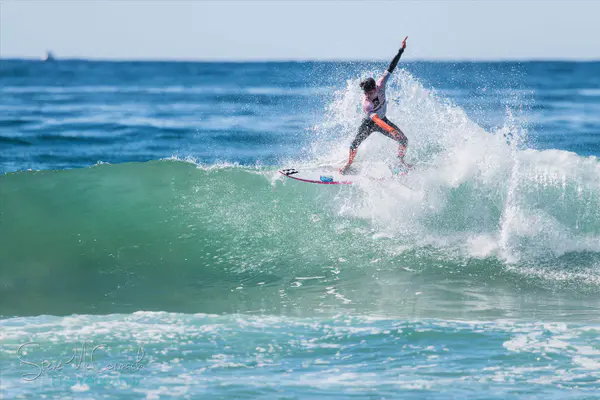Priority in surfing determines which surfer has the right to catch a wave. This rule helps ensure fairness and safety in the lineup. Without priority, surfers might constantly drop in on each other, leading to chaos and potential injuries. Priority is a crucial aspect of competitive surfing but is also relevant for free surfing to maintain order and respect among surfers.
The Importance of Priority
Priority prevents conflicts. It helps surfers know when it’s their turn. This rule is vital in competitions. It ensures that the best waves are ridden by the surfers who earn them. In free surfing, it maintains harmony in the water.
In a surfing competition, priority rules are strictly followed. Judges track each surfer’s priority status. The surfer with priority has the right to catch any wave they choose. If another surfer interferes, they can be penalized.
Priority Rules in a Heat
During a heat, surfers compete to catch the best waves. The priority rule is key here. At the start, no one has priority. The first surfer to catch a wave gains priority. Once they ride a wave, they lose priority, and it passes to the next surfer. This rotation continues throughout the heat.
Types of Priority Systems
There are different priority systems. The two main ones are the “one-on-one” and “three-man” priority systems. In a one-on-one heat, priority alternates between the two surfers after each wave. In a three-man heat, the surfer who caught the last wave goes to the end of the priority line.
Enforcing Priority Rules
Judges enforce priority rules. They observe each surfer’s actions. If a surfer breaks the priority rule, they are penalized. Penalties can affect a surfer’s score, reducing their chances of winning.
Priority in Free Surfing
In free surfing, priority is less formal but still important. Surfers use an informal system. Respect and communication are key. Surfers often follow an unspoken rule: the surfer closest to the peak of the wave has priority. This helps avoid collisions and ensures everyone gets a fair share of waves.
Common Priority Scenarios
Understanding common priority scenarios helps surfers know what to expect. Here are a few:
- Two Surfers on the Same Wave: The surfer closest to the peak has priority. The other surfer should pull back.
- Crossing Paths: If two surfers are on intersecting paths, the surfer who is further along the wave has priority.
- Interference: If a surfer with lower priority catches a wave, it is interference. They may face penalties.
Priority and Wave Selection
Priority influences wave selection. Surfers with priority can be more selective. They can wait for the best waves without worrying about interference. This strategic advantage can lead to higher scores.
Priority Strategies
Surfers use different strategies based on priority. When holding priority, a surfer can be patient. They can wait for the optimal wave. Without priority, a surfer must be more aggressive. They need to catch waves quickly to regain priority.
Communication is crucial in managing priority. Surfers often signal each other. A nod or a hand gesture can indicate who has priority. Respecting priority rules builds a positive surfing community.
New surfers should learn priority rules early. Understanding these rules helps them integrate into the surfing community. It also makes their surfing experience safer and more enjoyable.
Safety and Challenges
Safety is a top priority in surfing. Following priority rules reduces the risk of collisions. It ensures that surfers can focus on riding waves, not avoiding accidents.
Enforcing priority can be challenging. Conditions can change rapidly. Surfers might not always agree on who has priority. Judges and surfers need to stay vigilant and communicate clearly.
Evolving Priority Rules
Priority rules have evolved over time. They adapt to changes in the sport. As surfing grows, priority rules will continue to develop. This evolution helps maintain fairness and safety.Technology plays a role in enforcing priority. In competitions, electronic systems track priority. These systems provide real-time updates, helping judges and surfers.
Priority and Surfing Etiquette
Priority is part of surfing etiquette. Respecting priority shows respect for fellow surfers. It fosters a positive and respectful surfing environment.Local surf spots may have specific priority rules. Surfers should be aware of these local customs. Understanding and following local rules shows respect for the local surfing community.
See Also: Which Beach Has Water Sports in Goa?
Priority and Surf Schools
Surf schools teach priority rules to beginners. This education is crucial. It helps new surfers understand the importance of priority and integrate smoothly into the surfing community.
Big wave surfing presents unique challenges. Priority rules still apply but may be harder to enforce. Surfers in big wave conditions need to be even more vigilant about priority.
Priority and Surfing Competitions
In major surfing competitions, priority rules are strictly followed. These rules ensure that the best surfers have the opportunity to showcase their skills. Strict enforcement of priority maintains the integrity of the competition.
Historical Perspective on Priority and Future
The concept of priority has a long history in surfing. Early surfers developed informal rules to manage the lineup. Over time, these rules became formalized, leading to the current priority systems.Priority is deeply embedded in surf culture. It reflects the values of respect and fairness. Surfers who respect priority contribute to a positive and supportive surf community.
The future of priority in surfing will likely see further refinement. As the sport evolves, so will the rules. Innovations in technology and changes in competition formats will influence priority systems.
Conclusion
Understanding and respecting priority is crucial in surfing. It ensures fairness, safety, and enjoyment for all surfers. Whether in competitions or free surfing, priority rules help maintain order and respect in the lineup. Surfers who follow these rules contribute to a positive and respectful surfing community. As the sport continues to evolve, priority will remain a fundamental aspect of surfing, reflecting the values of respect, fairness, and safety.

